Disaster 2024: Japan hit by massive quake, fires, liquefaction, tsunamis!

01 January 2024 (06:31-UTC-07 Tango 06) 11 Dey 1402/19 Jumada t-Tania 1445/20 Gui-Chou 4721/01 январь 2024 года
Noto Peninsula (能登半島, Noto-hantō) is the epicenter of a 7.6 magnitude Richter scale (7-Japan Meteorological Agency [JMA] scale) earthquake that struck at 16:10 Japan time. An earthquake warning was issued just before the quake. Evacuations underway for Ishikawa Prefecture (located on the center of the west coast of Honshu). Ishikawa-Wajima (Wajima City) is on fire, the local fire department reports they are overwhelmed.
Buildings are collapsed, with people underneath. Small tsunamis are coming ashore in surrounding west-coast prefectures on Honshu and Hokkaido.
A live TV news reporter, in one city, said mud was pushing up into the streets. At least 49 aftershocks on the Noto Peninsula.
In the affected prefectures, communication services (including fiber optics) are down, bank services down, some rail transport is down, airline services suspended, hospitals reporting many injured people showing up, police in Nanao City report at least two people confirmed dead, Nanao Ohta Thermal (coal fired) Power Station shutdown. A nuclear power facility in the area reports no problems as it was already offline when the earthquake struck.
A second quake warning was issued.
March 2022: FUKUSHIMA REDUXE!!! 7+ QUAKE, TSUNAMIS, 6- QUAKE, NUKE PLANTS OFFLINE, TRAIN DERAILS!

09 MAY 2023 (20:55-UTC-07 Tango 06) 19 Ordibehesht 1402/18 Shawwal 1444/20 Ding-Si 4721/09 май 2023 года
Recently, the University of Washington announced the discovery of “warm, chemically distinct liquid shooting up from the seafloor about 50 miles off Newport, Oregon.”
Video of the underwater vent named Pythias Oasis:
KCPQ news report:
FEMA Region 10, 2023: 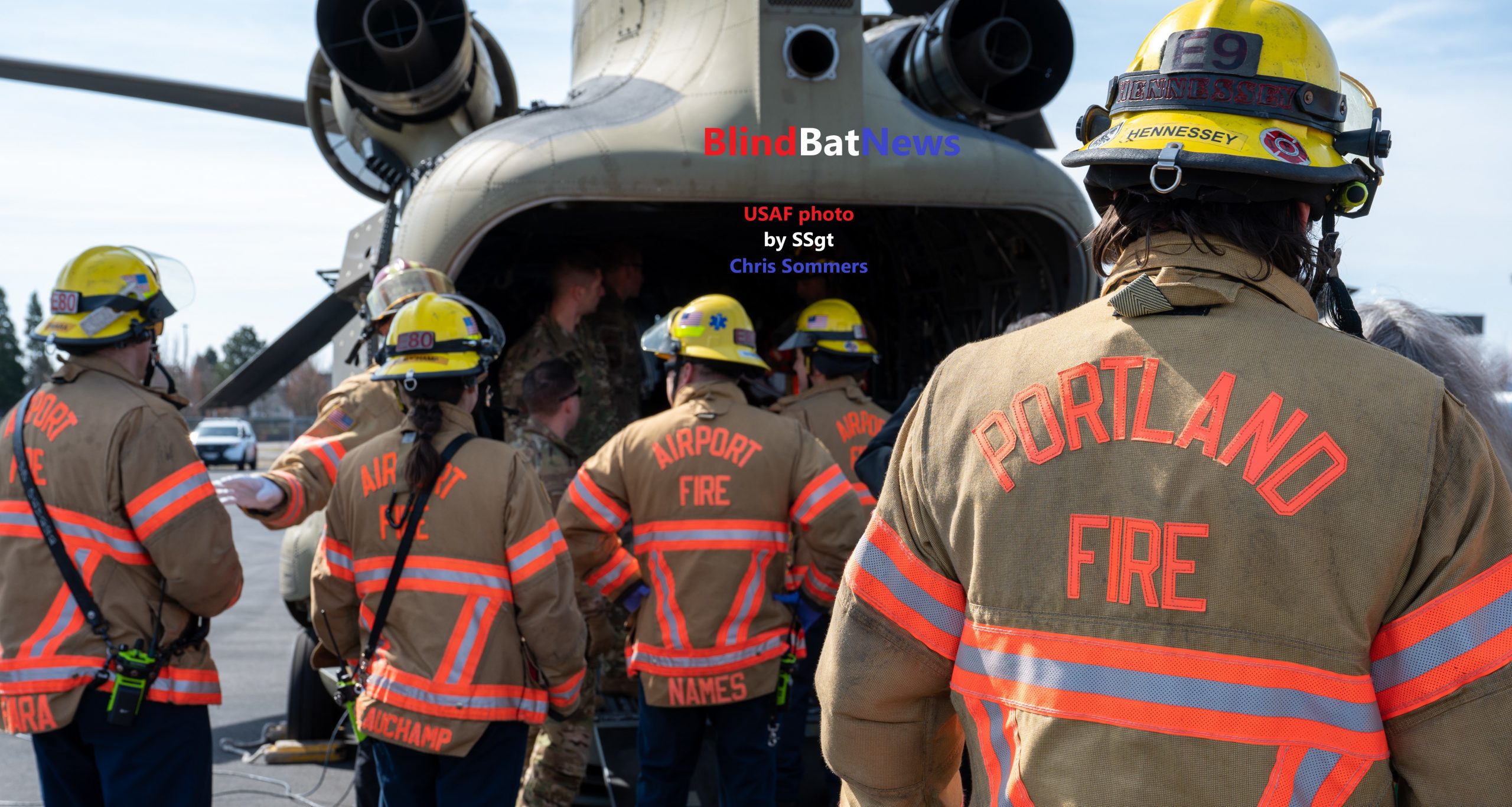 ULTIMATE CADUCEUS; “SURGE THE SYSTEM”, MASS-MED-EVACUATION!
ULTIMATE CADUCEUS; “SURGE THE SYSTEM”, MASS-MED-EVACUATION!
FEMA Region 10, June 2022: CASCADIA MEGATHRUST EVENT; U.S. ARMY PREPS FOR “SUPER BOWL OF DISASTERS”!
FEMA Region 10, January 2022: 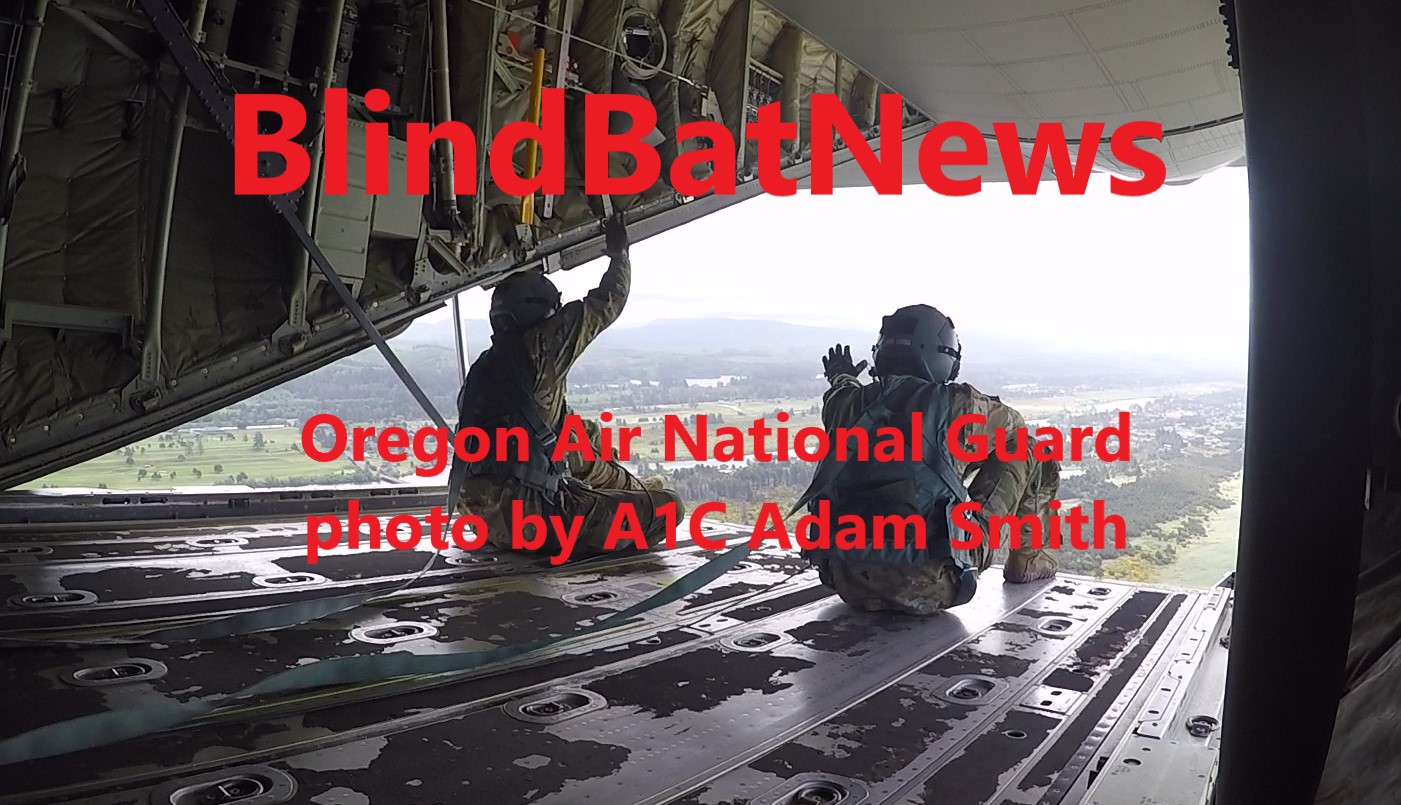 CASCADIA AIRLIFT; JUST IN CASE YOU GET ISOLATED BY THE MASSIVE QUAKE & TSUNAMI
CASCADIA AIRLIFT; JUST IN CASE YOU GET ISOLATED BY THE MASSIVE QUAKE & TSUNAMI
FEMA Region 10, 2021: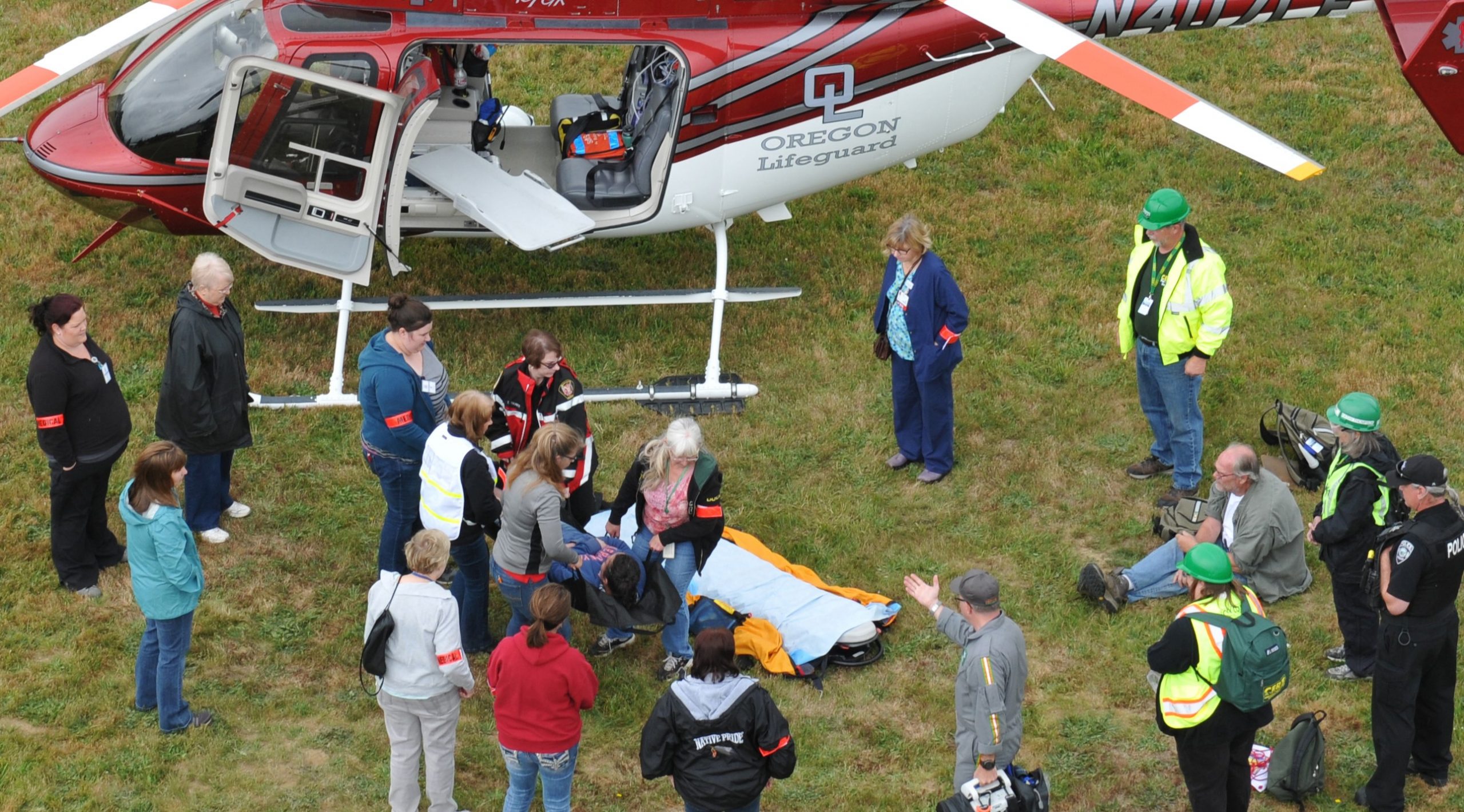 CASCADIA RISING; PREP FOR “…EXTRAORDINARY LEVELS OF MASS CASUALTIES…”!
CASCADIA RISING; PREP FOR “…EXTRAORDINARY LEVELS OF MASS CASUALTIES…”!

“If and when Cascadia happens, the whole West Coast is going to experience upset conditions. Things are going to be upside down.”-Erik Petersen, U.S. Army Corps of Engineers-Portland District-Willamette Valley Operations
The U.S. Army Corps of Engineers, Portland and Seattle Districts, are concerned about the 30 dams in Oregon and Washington, and the coming 9.2 magnitude megathrust earthquake known as the Cascadia Event.
During FEMA’s (Federal Emergency Management Agency) 14-16JUN2022 Cascadia Rising training days, the U.S. Army Corps of Engineers inspected those 30 dams, saying “It’s the Super Bowl of disasters for emergencies, and you’ve got to have a team, you’ve got to practice, you’ve got to have some scrimmages, you’ve got to play some games, and you’ve got to go the playoffs before you get to the Super Bowl.”-Mark McKay, U.S. Army Corps of Engineers-Portland District Catastrophic Disaster Response Program
After Japan’s 11MAR2011 quake and tsunami, geologists and seismologist working for the U.S. government ‘got woke’ to the fact that old stories about an even bigger event hitting the Pacific Northwest of North America might be true, and a review of historical data, and new research, showed there really is a Super Bowl of disasters waiting to strike. The last estimated magnitude 9.0 quake and tsunami to hit the Pacific Northwest coastline was on 26JAN1700. The geologic data shows the Cascadia Event is relatively cyclic, meaning you can somewhat expect such a disaster every so many hundreds of years, and some Earth science ‘experts’ say it is overdue.
The inspection of the dams a week ago is not the first time, Army Corps of Engineers have spent several year now prepping the dam sites they are responsible for. One of those preparations is regular seismic studies and risk assessments of the dams. Another is to install briefcase sized battery powered satellite communications systems on at least a dozen remote dam sites. The age of electronic communications/social media has an Achilles Heel; electric power and communication links. The megathrust quake is expected to destroy any old fashioned communication transmission lines (both buried and telephone poles), as well electrical power transmission, cell phone service will also go down. People will need battery operated radios and/or phones that directly connect to satellites (Amateur Radio Emergency Services-Cascadia June 2022).
During this year’s Cascadia Rising event, the Corps of Engineers also realized they needed to stockpile food and water for the personnel who would be working on the remote dams after such a disaster.
The Corps of Engineers revealed another problem; all the dam reservoirs are the fullest they’ve been in the past few years, due to heavy late Spring rains. If the megathrust was to pop now, then all that extra water will exacerbate efforts to prevent rivers from flooding downstream.
Yet another problem, pointed out during this year’s exercise, is that there might not be anywhere for helicopters to land: “If the earthquake hits, this parking lot might not even be here.”-Helicopter pilot who flew Local Damage Assessment Team (LDAT) to the top of Cougar Dam, in Oregon, during Cascadia Rising 2022
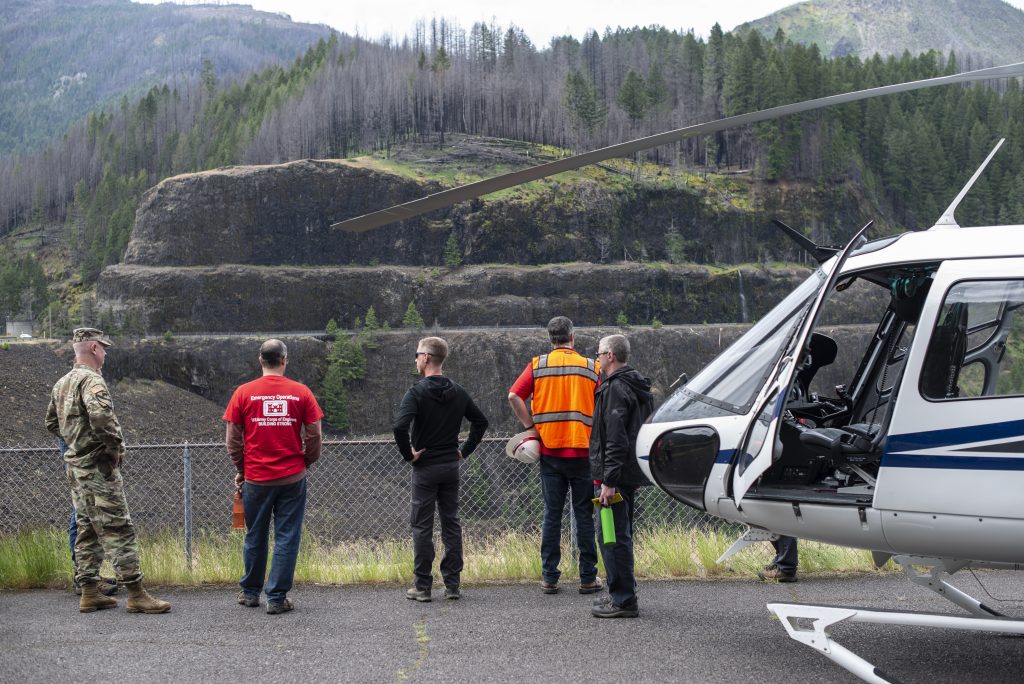
Parking lot ‘landing zone’ at Cougar Dam, Oregon. U.S. Army Corps of Engineers photo by Chris Gaylord, 15JUN2022.
FEMA’s worst case scenario is a tsunami up to 80 feet high, more than a million buildings damaged, thousands of people dead, even more injured and homeless, and that is if the epicenter was near the city of Florence, Oregon. The epicenter could actually be anywhere along the 7-hundred mile Cascadia Subduction Zone, which stretches from Northern California to British Columbia.
King County, Washington, tries to show you what the Cascadia Megathrust Event will look like:
Washington Emergency Management Division: Cascadia Rising 2022 (CR22) Exercise Series
Lincoln County, Oregon: Community Participation Cascadia Rising
Disaster, May 2022: 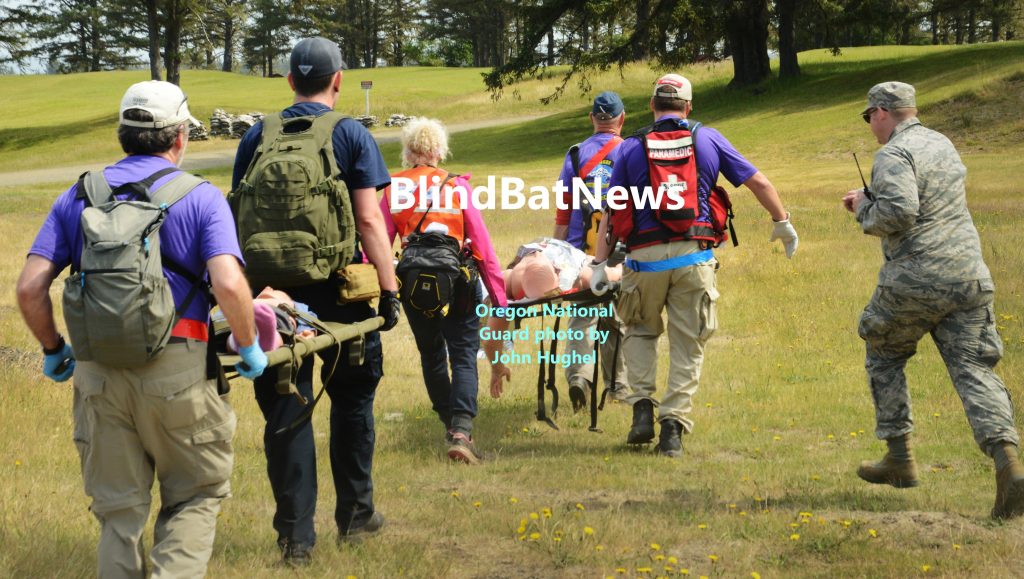 CASCADIA RISING, F-E-M-A PREPARATIONS, CANADA ONBOARD!
CASCADIA RISING, F-E-M-A PREPARATIONS, CANADA ONBOARD!

06 May 2022 (08:36-UTC-07 Tango 06) 16 Ordibehest 1401/04 Shawwal 1443/06 Yi-Si 4720
“The physical devastation will be significant, and the humanitarian impacts will be felt far beyond the earthquake zone. Now is the time to come together, question, and challenge our plan so that when one of the biggest natural disasters to strike our nation takes place, we are ready to act.”-Willie G. Nunn, FEMA Region 10
In the past week the Federal Emergency Management Agency’s (FEMA) Region 10 conducted Cascadia Rising 2022 Rehearsal of Concept ‘pre-exercise’ (also calling it a “discussion-based exercise”) at the Pierce County Readiness Center on Camp Murray, Washington.
FEMA refers to the coming Cascadia disaster as CSZ Earthquake and Tsunami. CSZ stands for Cascadia Subduction Zone.
A much larger multi-state exercise is scheduled for June 2022, involving the National Guard of the states of Alaska, Idaho, Oregon, Washington, as well as various tribes and federal agencies, Department of Defense, and the Canadian Province of British Colombia.
KING5 connects CoViD with Cascadia:
Oregon creates new Cascadia proof Treasury building:
Washington State’s Emergency Management Division says having an old fashioned radio is key to survival:
Blind Bat News 2018: IDAHO MILITIA PROVIDES ITS OWN CELL SERVICE, TO SURVIVE COMING NATURAL DISASTER?
‘Cascadia Rising’ exercises have been ongoing since 2016.
Cascadia Airlift: 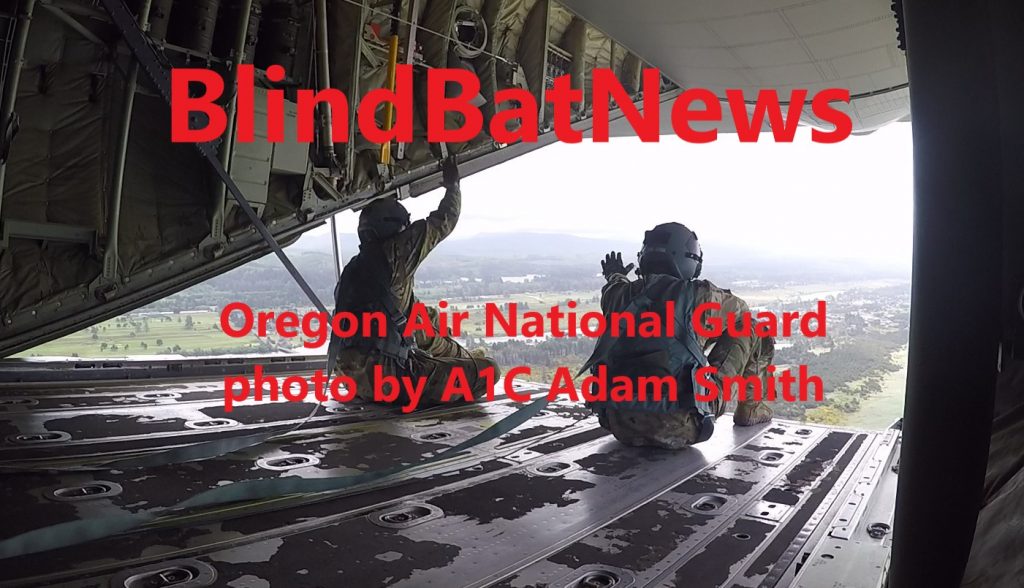 JUST IN CASE YOU GET ISOLATED BY THE MASSIVE QUAKE & TSUNAMI
JUST IN CASE YOU GET ISOLATED BY THE MASSIVE QUAKE & TSUNAMI
Cascadia Rising 2021: 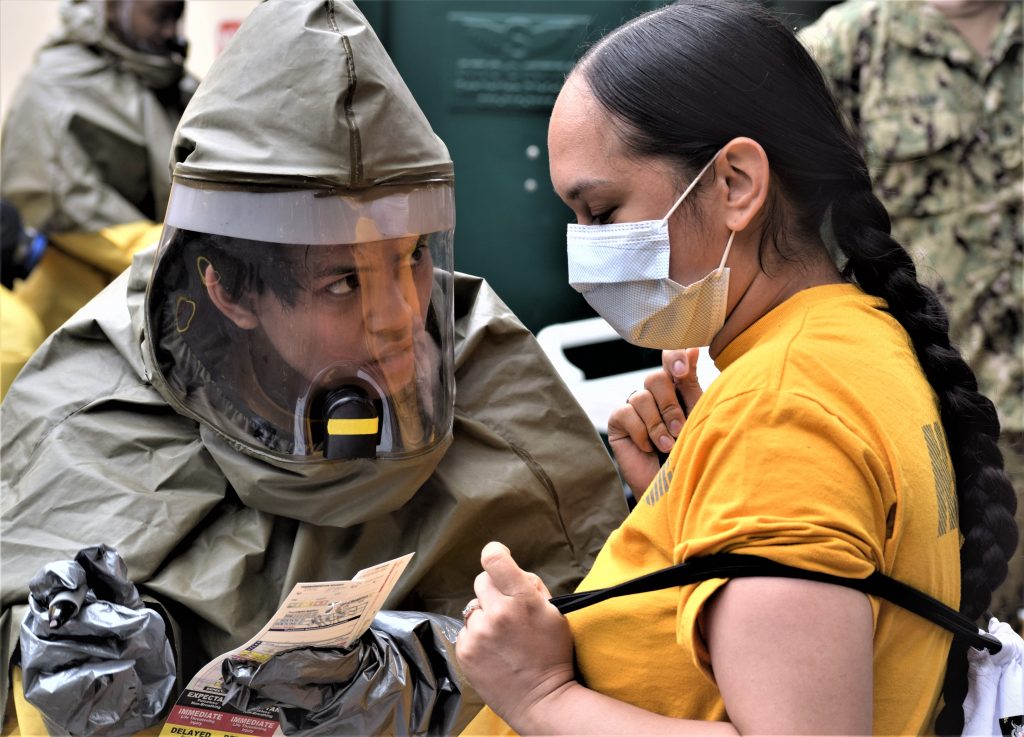 OPERATION BLACK WIND, BREMERTON HIT BY MASSIVE QUAKE & CONTAMINATION?
OPERATION BLACK WIND, BREMERTON HIT BY MASSIVE QUAKE & CONTAMINATION?
“…EXTRAORDINARY LEVELS OF MASS CASUALTIES…”!
U.S. Disaster 2022: 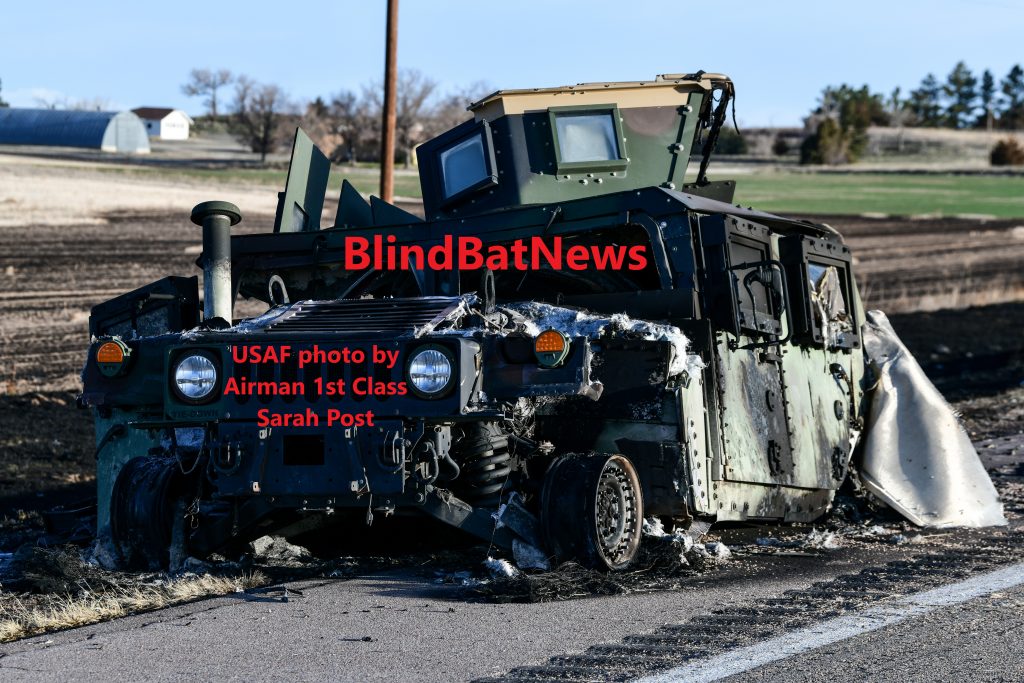 U.S. MILITARY VEHICLES UNDER FIRE! GRATEFUL CHILD THANKS NATIONAL GUARD AS FIRE APPROACHES HOMES!
U.S. MILITARY VEHICLES UNDER FIRE! GRATEFUL CHILD THANKS NATIONAL GUARD AS FIRE APPROACHES HOMES!
Alarm Black: 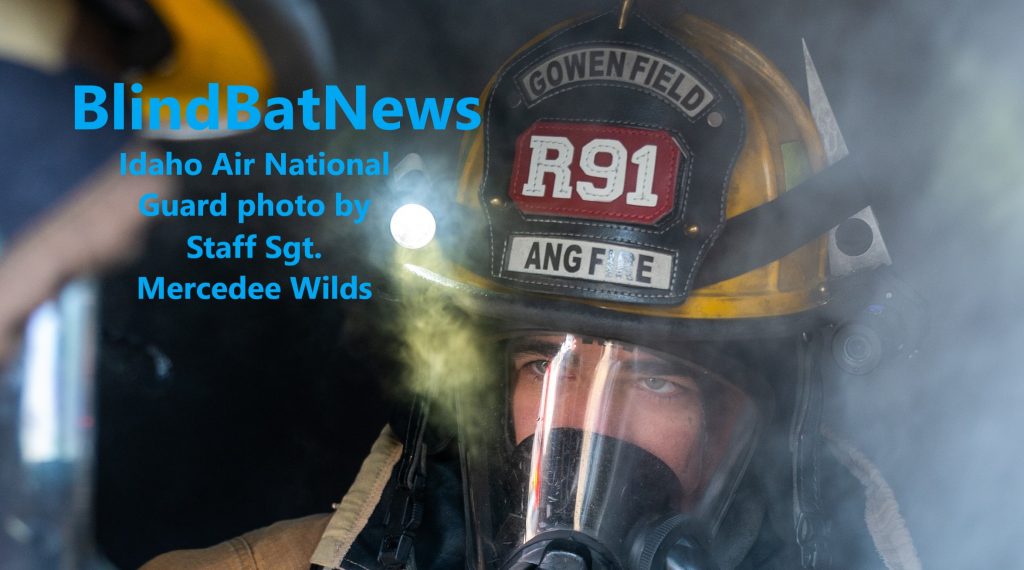 In February 2022, the Idaho National Guard prepared for manmade and natural disasters on Gowen Field.
In February 2022, the Idaho National Guard prepared for manmade and natural disasters on Gowen Field.
Hurricane 2021: 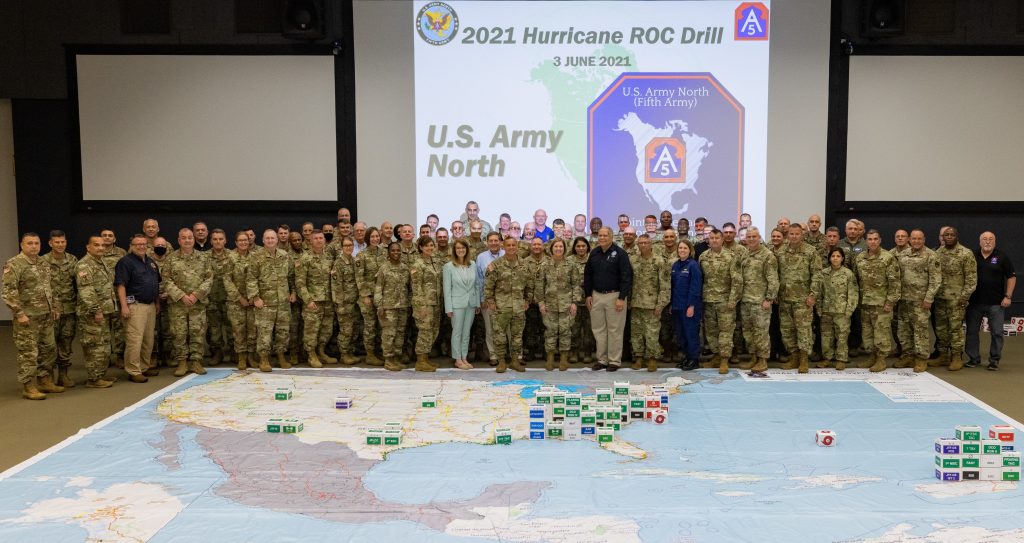 U.S. ARMY LOVES GIANT MAPS, FEMA PREPS FOR NATION-WIDE DISASTERS + PANDEMIC!
U.S. ARMY LOVES GIANT MAPS, FEMA PREPS FOR NATION-WIDE DISASTERS + PANDEMIC!
Fukushima 2011:BOOKS THAT TELL YOU HOW TO ESCAPE A NATURAL DISASTER, YOU CAN’T RELY ON YOUR CELL PHONES

16 March 2022 (12:11-UTC-07 Tango 06) 25 Esfand 1400/12 Sha’ban 1443/14 Gui Mao 4720
The first quake (at about 08:00 Mountain Time North America) maxed out Japan’s magnitude scale, which tops out at 7. First quake was felt Fukushima Prefecture’s Sōma City, at a depth of 63km (USGS data). Second quake of less than 6 on the Japan mag-scale reported in other areas. Nuclear power plants in Fukushima now offline, sudden water loss in reactors and cooling pools for spent fuel rods.
Fukushima nuke plants that went offline supply power to Tokyo. So much for A-I/’smart’ homes/apartments, residence who live in those computer controlled residences say the doors automatically locked them inside the home due to the power outage! One bullet-train traveling from Fukushima has derailed. Avalanche warning issued.
I checked recent earthquake records and it appears Miyagi Prefecture, which borders Fukushima Prefecture, has been experiencing mid-level magnitude quakes for past several weeks.
Video of this morning’s (North America time, during the night in Japan) earthquake showed what looks like transformers exploding in the distance. At least one death in Sōma City reported.
Pacific Ring of Fire, 2018: JAPAN, MODERN DAY ATLANTIS
Fukushima, Five Years Later, 2016: WIFI SPREADING RADIATION! BULLET PROOF VEST BLOCKS RADIATION? MORE MYSTERY RADIATION FROM FUKUSHIMA! TOMATOES BLOCK RADIATION?

“The purpose of the exercise is to demonstrate a proof-in-concept that Kingsley Field is capable of hosting large-scale cargo aircraft in the event of a Cascadia Subduction Zone natural disaster.”– Lieutenant Colonel Chris Wright, 173rd Fighter Wing, Oregon Air National Guard
In June 2019, the Oregon Air National Guard conducted the Cascadia Airlift disaster response exercise. It also included active U.S. Air Force units from Little Rock Air Force Base in Arkansas, and Yokota Air Base in Japan.
The aircrews flew over the Astoria area of Oregon, practicing dropping humanitarian supplies from their C-130J Super Hercules aircraft. Oregon’s Kingsley Field has been selected as a location that might still be accessible after a CSZ (Cascadia Subduction Zone) event, and thereby allow government disaster response personnel to operate from.
Oregon Air National Guard music video report, by Airman First Class Adam Smith, about the 2019 Cascadia Airlift Exercise:
But this was not the first Cascadia Airlift exercise, the first one was in July 2018, also in Oregon. This involved C-130Js from Arkansas and Oregon’s 173rd Fighter Wing, on Kingsley Field. This shows the concern over a CSZ as the 173rd operates F-15 Eagle fighters, not C-130J cargo planes: “…we don’t normally host airlift. It was a blank slate and first proof-of-concept.”-Lieutenant Colonel Chris Wright, 173rd Fighter Wing, Oregon Air National Guard
Oregon Air National Guard music video report, by Staff Sergeant Riley Johnson and Technical Sergeant Jason Van Mourik, about the 2018 Cascadia Airlift Exercise:
The Cascadia Subduction Zone is a fault that extends more than 6-hundred miles up the Pacific Coast, from Northern California to Canada, and historically (about every 3-hundred years) has generate 9+ magnitude catastrophic earthquakes, followed by massive tsunamis.
Cascadia Rising 2021:  OPERATION BLACK WIND; BREMERTON, WASHINGTON, HIT BY MASSIVE QUAKE & CONTAMINATION?
OPERATION BLACK WIND; BREMERTON, WASHINGTON, HIT BY MASSIVE QUAKE & CONTAMINATION?
Cascadia Rising: Idaho, Oregon, Washington PREP FOR 2022, “…EXTRAORDINARY LEVELS OF MASS CASUALTIES…”!

“To our knowledge, this is the first time, at least at Navy Medicine commands, to have a fire engine pump hundreds of gallons of water to a DECON team to use in helping decontaminate patients.”-Terry Lerma, Naval Hospital Bremerton emergency manager
Preparations for the overdue Cascadia Event continues, this time striking the U.S. Navy’s hospital on Bremerton, Washington.
During the second week of July 2021, Naval Hospital Bremerton conducted Operation Black Wind (in conjunction with Citadel Rumble) to assess how to respond to a catastrophic natural disaster.
Operation Black Wind’s scenario is set immediately after ‘a sudden and significant seismic event’ that lasted for at least one minute. It also involved military personnel becoming sick due to a haz-mat truck overturning as a result of the quake. The scenario of massive amounts of hazardous materials being released and affecting the local population has only recently been added to the U.S. Department of Defense/FEMA’s disaster response training.
Citadel Rumble is a yearly large scale U.S. Navy ‘all hazard exercise’ held across the West Coast of the United States: “This exercise readies our personnel for response and recovery before, during and after a natural disaster or other all-hazard events. Installations in our West Coast regions face risk of damaging earthquakes and wildfire encroachment, so this training is vital to expedite recovery and maintain mission readiness should such events occur.”– Mark Sinder, Director of Operations for Commander, Navy Installations Command
PREP FOR 2022, “…EXTRAORDINARY LEVELS OF MASS CASUALTIES…”!

“….plan, organize, equip, train, exercise for responding to and recovering from a catastrophic incident resulting in extraordinary levels of mass casualties, damage or disruption severely affecting the population, infrastructure, environment, economy, morale and/or government functions.”-Major General Bret D. Daugherty, Washington National Guard
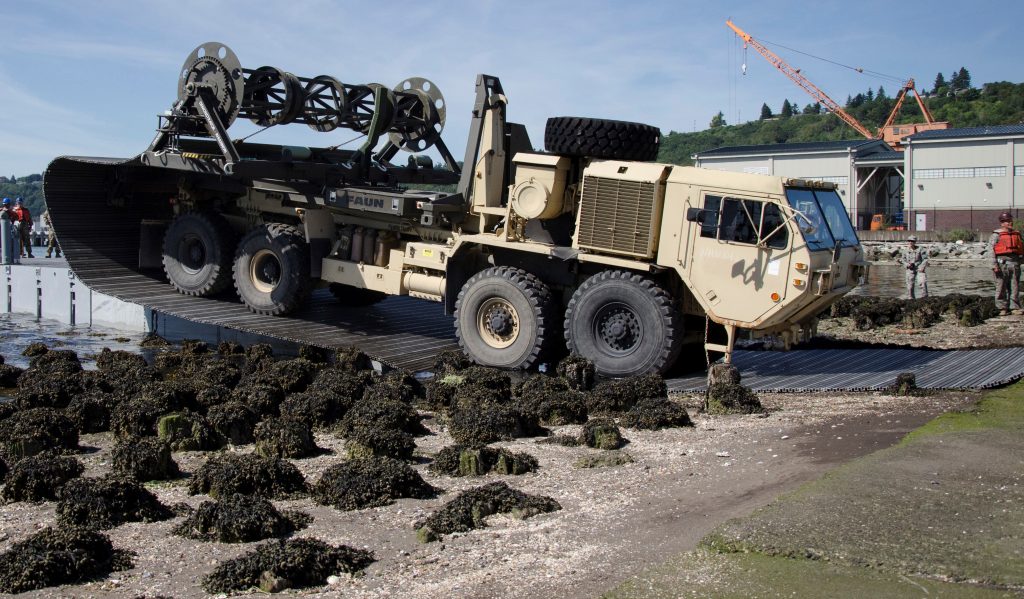
Since a massive tsunami would render all the sea ports useless, on 05JUN 2016 they practiced using a Heavy Ground Mobility System (HGMS) truck to deploy a temporary modular roadway. This is known as a Joint Logistics Over the Shore (JLOTS) operation. Washington Army National Guard photo by Sergeant Michael Tietjen.
Video of Modular Roadway deployment:
Video of JLOTS operation:
Video report explaining why JLOTS would be needed after a Cascadia Event, Washington Army National Guard’s 331st Transportation Company boasts that it is the only U.S. unit with this specific Combined Joint Logistics Over-the-Shore (CJLOTS) configuration:
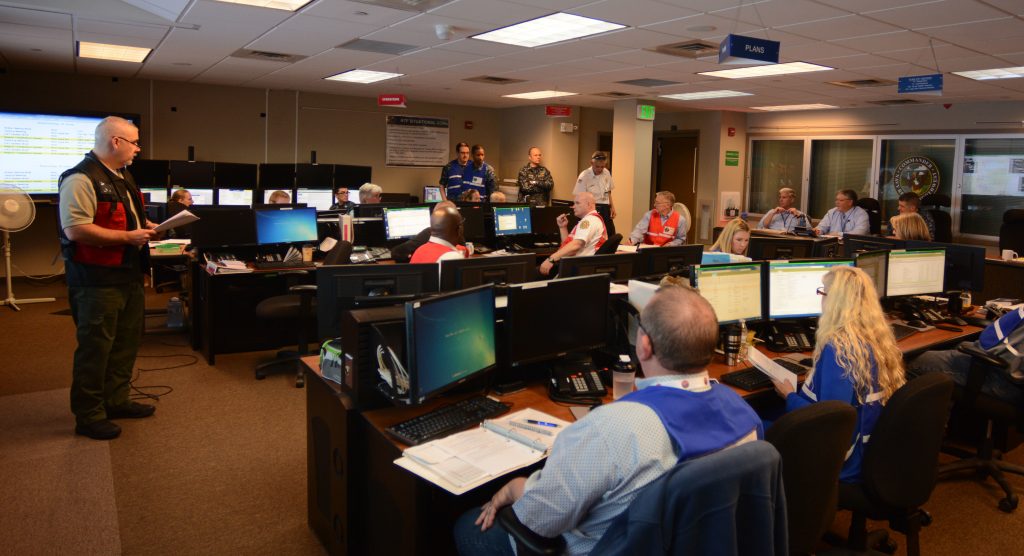
Navy Region North West (NRNW) Operations Center, in Washington state, will serve as a command & control after a CSZ event. U.S. Navy photo by Mass Communication Specialist First Class Jeffry Willadsen, 08JUN2016.
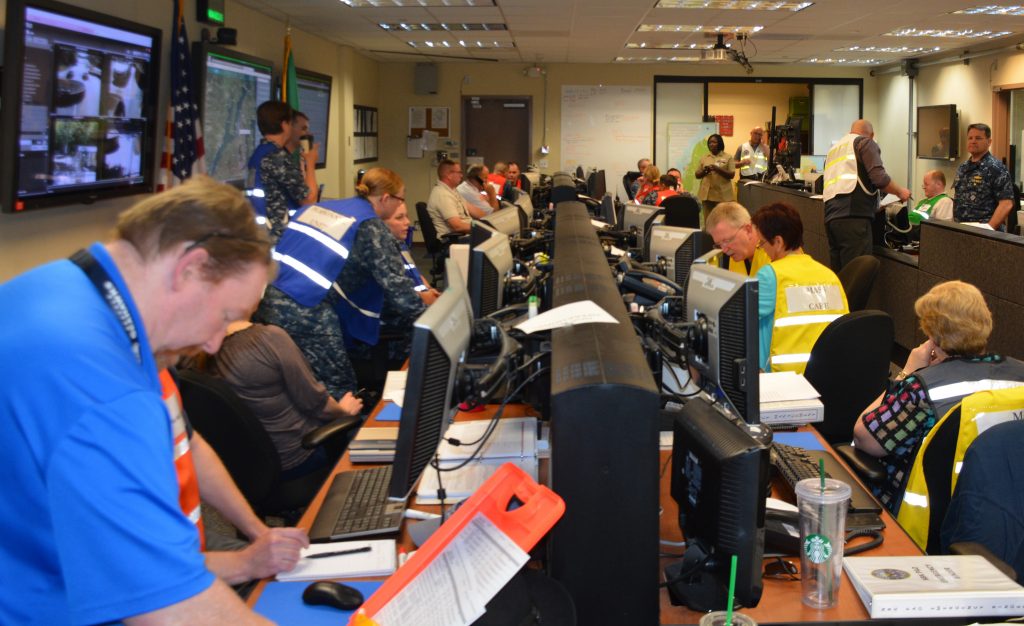
Cascadia Rising 2016 was directed from Naval Base Kitsap, Washington, in coordination with FEMA. U.S. Navy photo by Petty Officer Third Class Jessica Maue.
In 2016, the U.S. Department of Defense (DoD), Federal Emergency Management Agency (FEMA), as well as Oregon and Washington National Guards, conducted a training event called Cascadia Rising. They are preparing for a catastrophic earthquake and tsunami, resulting from an overdue jolt along the Cascadia Subduction Zone (CSZ) off the Pacific Northwest coast of the United States.
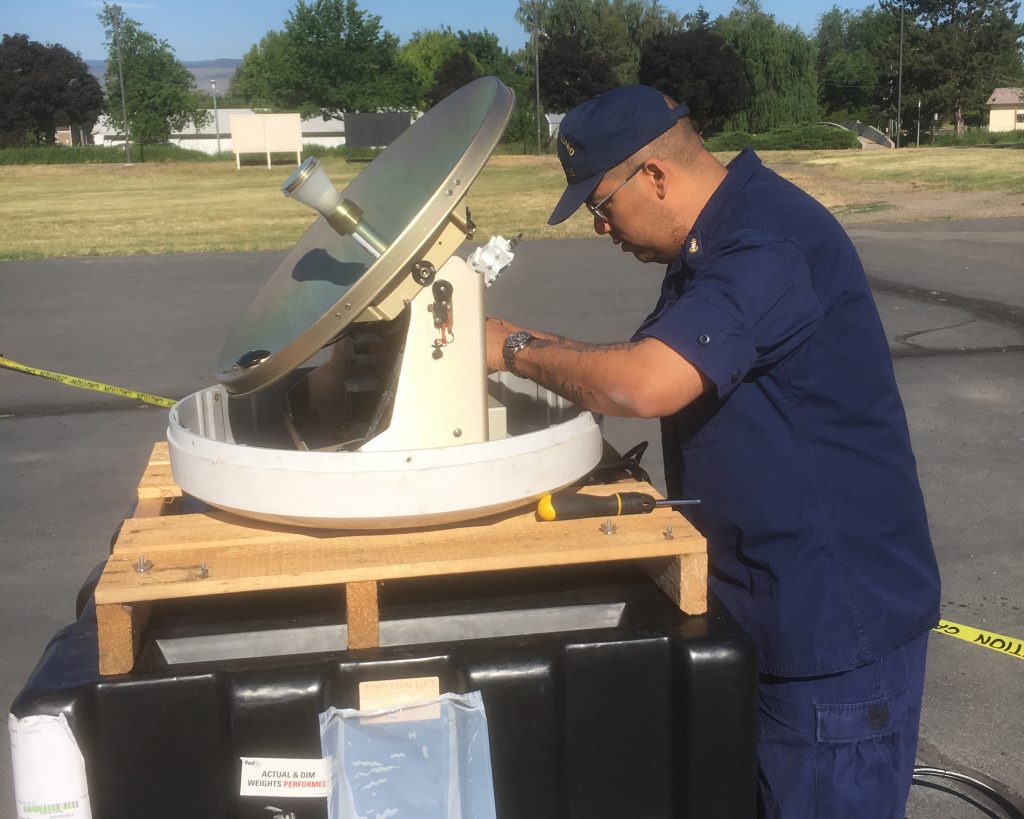
07JUN2016, U.S. Coast Guard tested their Deployable Contingency Communications System near Ellensburg, Washington. U.S. Coast Guard District 13 photo.
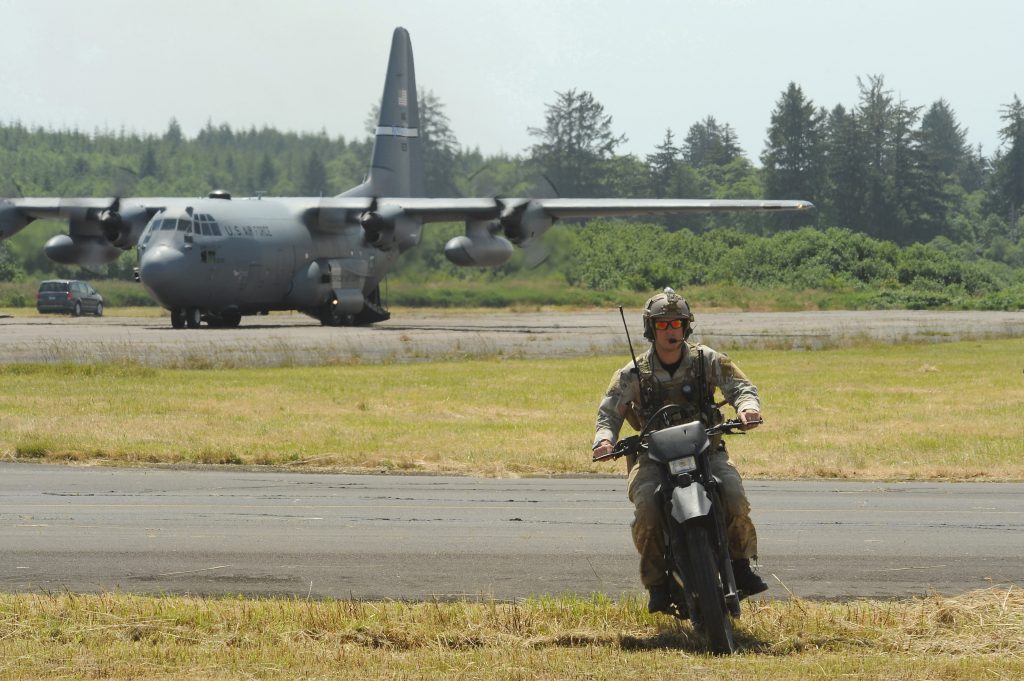
07JUN2016, Oregon Air National Guard practiced emergency supply operations using TACPs and C-130s. Oregon Air National Guard photo by Technical Sergeant Emily Thompson.
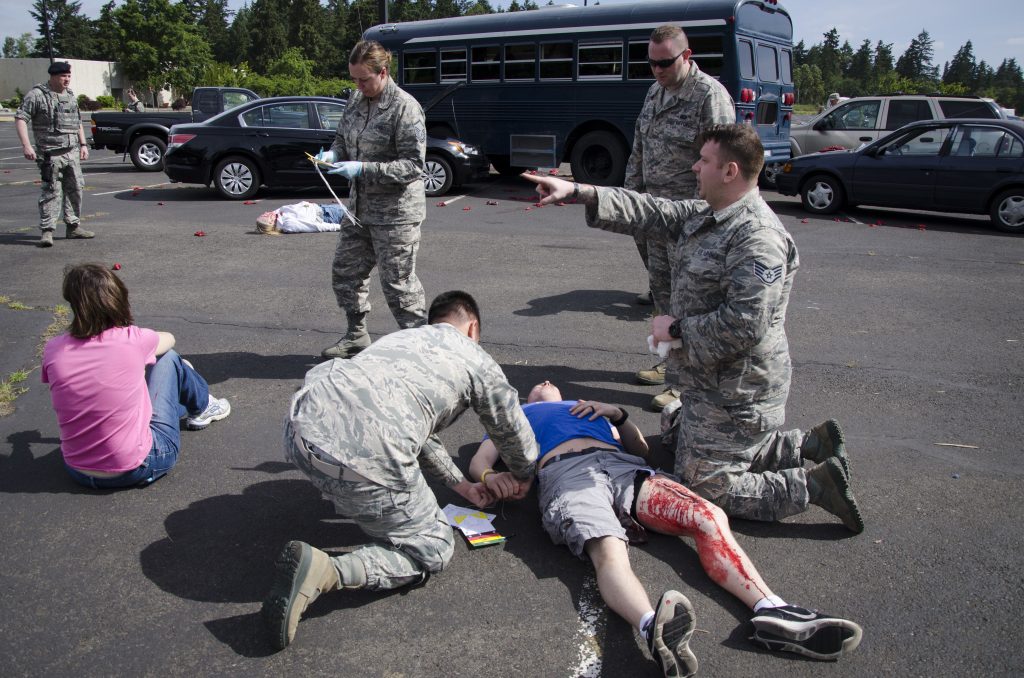
Mass casualty training on Joint Base Lewis-McChord, 08JUN2016. Washington Army National Guard photo by Sergeant Michael Tietjen.
The Idaho, Oregon and Washington National Guards are prepping for another Cascadia Rising training event, to be held in June 2022, called Cascadia Rising 2022 (aka CR22). FEMA is calling the CR22 training National Level Exercise 2022 (NLE 2022). Supposedly, the CR22/NLE 2022 is a scenario that is placed four days after the CSZ event, an event that is expected to affect at least three U.S. states, with an expected 70-thousand plus casualties. Idaho could become a ‘refugee’ center for survivors from Washington and Oregon. (Canada’s British Columbia is also going to be affected)
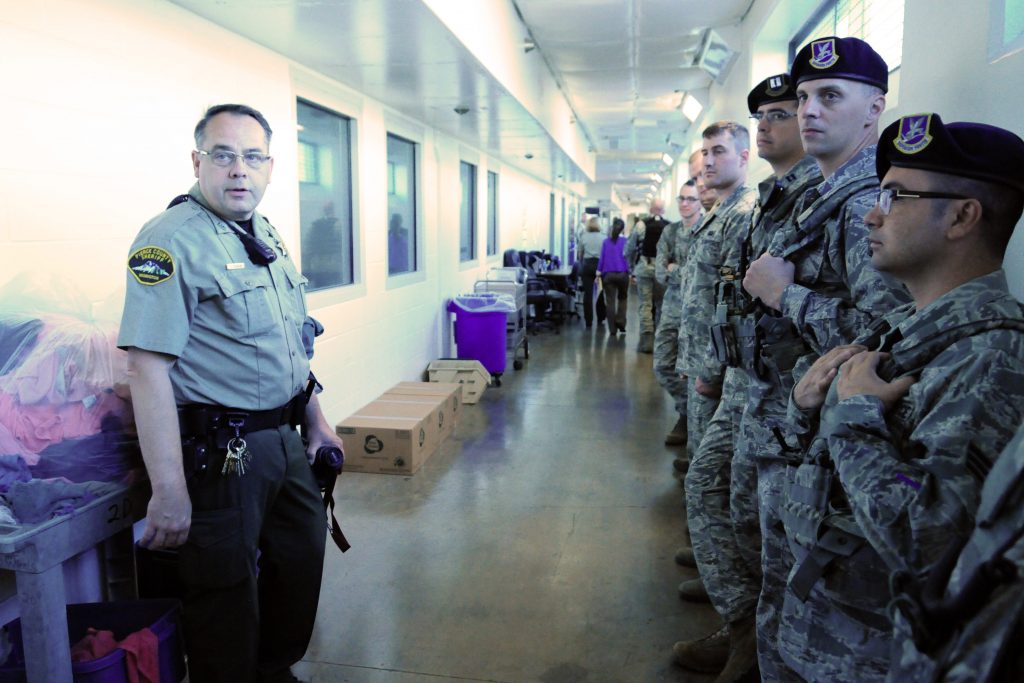
Washington Air National Guard joined with Pierce County Corrections to prevent any breakouts at the Pierce County Jail, 08JUN2016. Washington Air National Guard photo by Technical Sergeant Paul Rider.
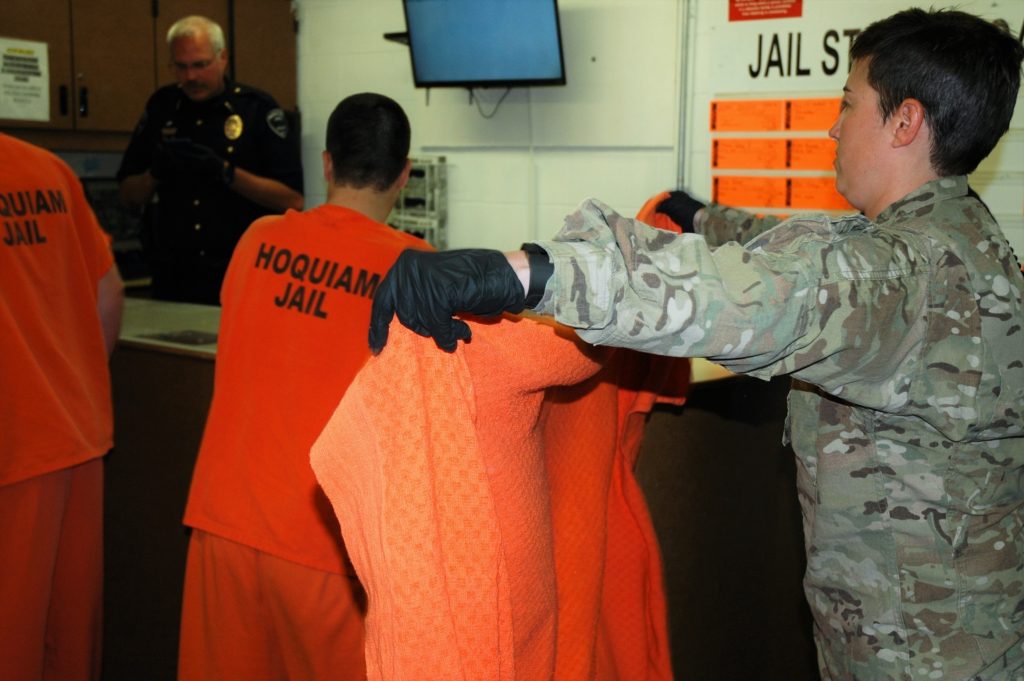
While Washington’s Air National Guard tried to prevent a jail break, Washington’s Army National Guard help prisoners ‘escape’ the Hoquiam Jail due to approaching tsunami, 09JUN2016. Washington National Guard photo by Captain Colette Muller.
The first Cascadia Rising event was in 2016, and was considered to be the largest ever disaster response training in the U.S. Pacific Northwest. Cascadia Rising 2016 revealed to authorities that everybody, and every local government operation, needed to be self-supplied for a minimum of two weeks to survive such a catastrophe: “The Cascadia Rising 2016 exercise highlighted a number of critical areas that we, the emergency management community, should improve before this fault ruptures, which will impact large portions of our residents and infrastructure. …..The exercise highlighted a number of infrastructure interdependencies our residents have come to rely on, such as electricity, communications, fuel, water and our roads. Most of these sectors would be heavily disrupted after a CSZ event and plans are being developed and exercised that focus on the efficient recovery of these essential services.”-Sharon Loper, FEMA Region 10
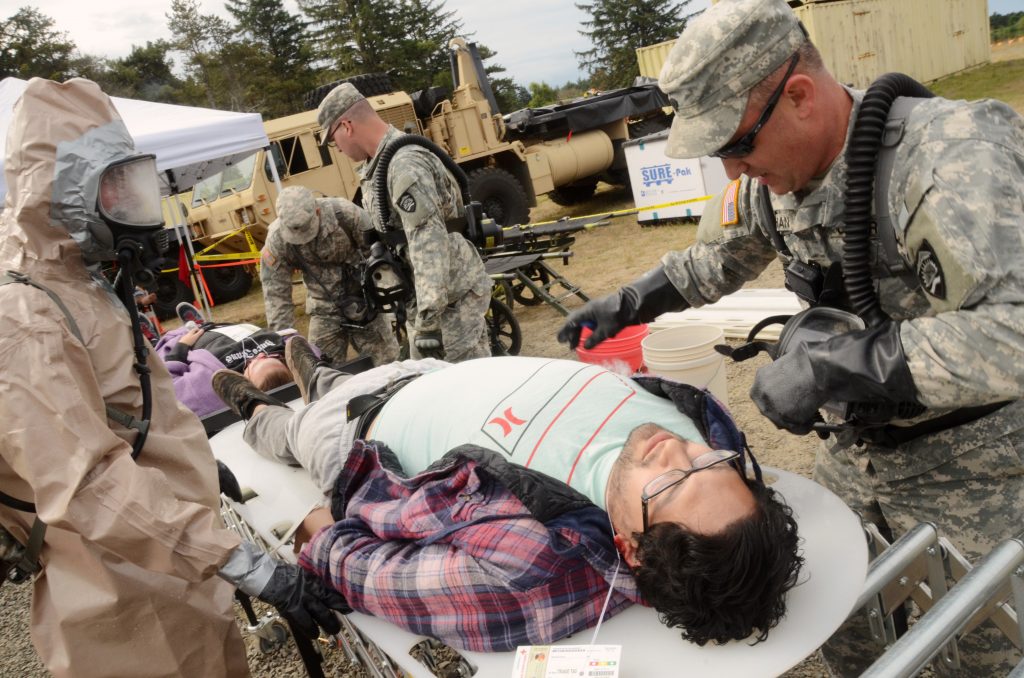
Kentucky and Oregon National Guard conducted mass casualty training at Camp Rilea. Oregon Air National Guard photo by Technical Sergeant John Hughel.
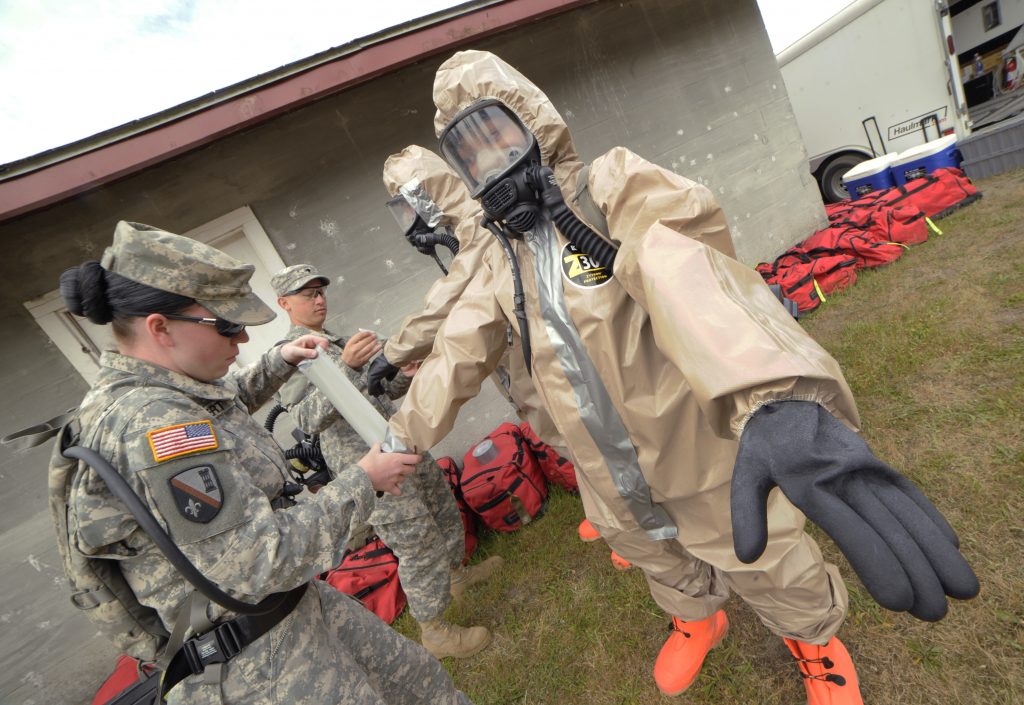
It is also expected that the CSZ event will create toxic environments. Oregon Air National Guard photo by Technical Sergeant John Hughel.
To show you how seriously the DoD and FEMA are taking the overdue CSZ jolt, Cascadia Rising 2016 involved almost 20-thousand personnel from the U.S. Air Force Reserve, U.S. Navy, U.S. Coast Guard, Kentucky National Guard, Oregon and Washington National Guards, Tribes, and civilian emergency response agencies.
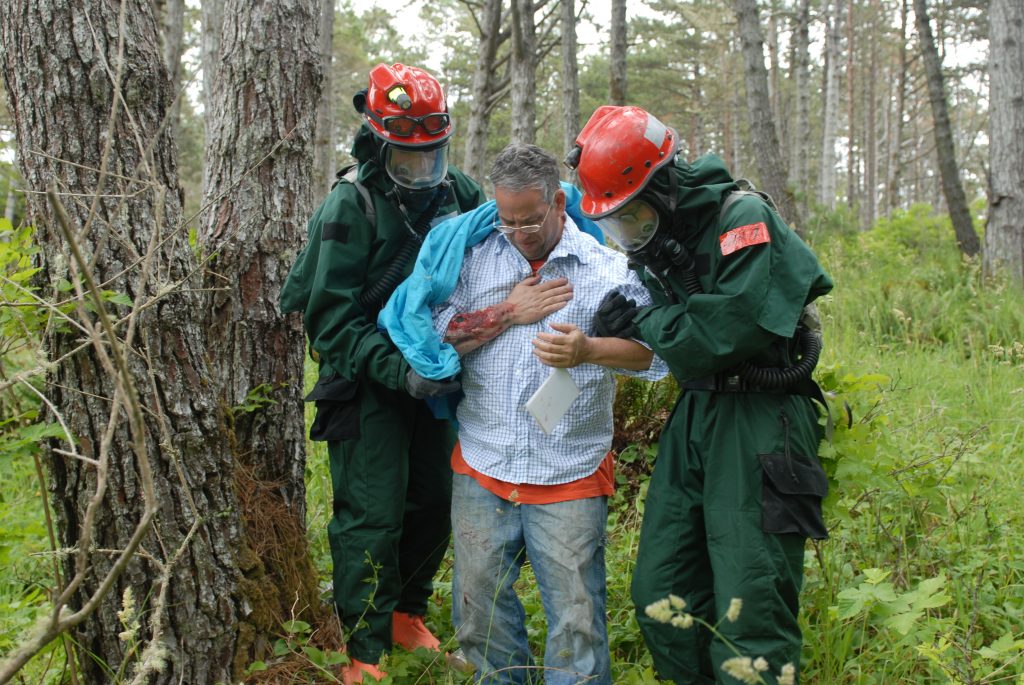
Wearing contamination protective gear, Kentucky National Guard conducted rescues of people ‘swept’ into the forest. Kentucky National Guard photo by First Lieutenant Michael Reinersman.
Video interviews, by Staff Sergeant Amy Elker, concerning the nine Tribes in Oregon, in relation to the coming CSZ event:
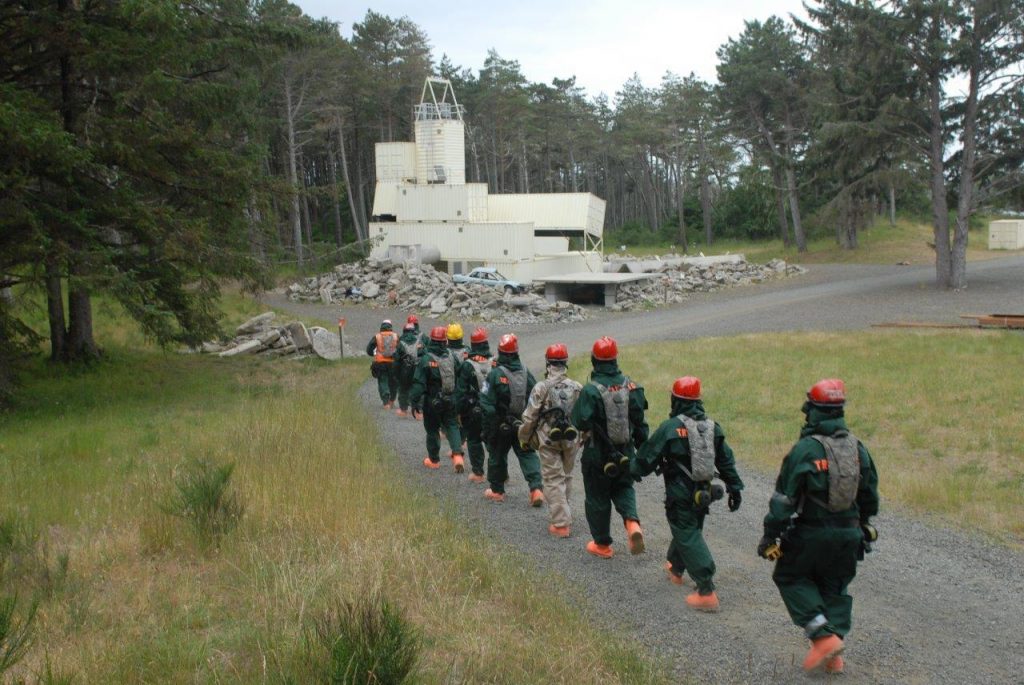
Wearing contamination protective gear, Kentucky National Guard approach a collapsed building on Camp Rilea, Oregon, 08JUN2016. Kentucky National Guard photo by First Lieutenant Michael Reinersman.
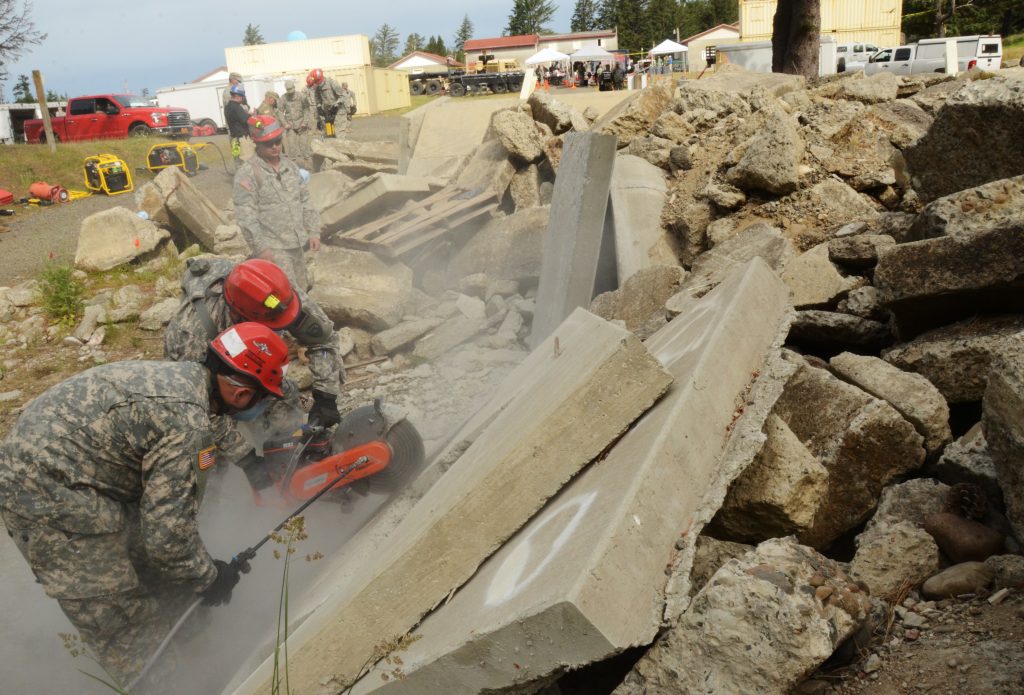
Searching trough collapsed buildings, 09JUN2016. Oregon Air National Guard photo by Technical Sergeant John Hughel.
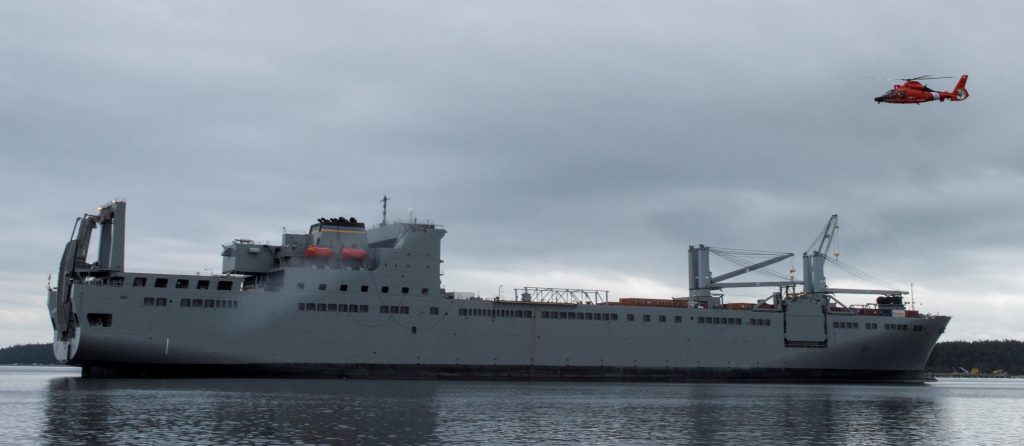
U.S. Coast Guard Mobile Medical Ship during Cascadia Rising exercise at Naval Magazine Station Indian Island, Washington, 09JUN2016. U.S. Coast Guard photo by Petty Officer Third Class Andrea Anderson.
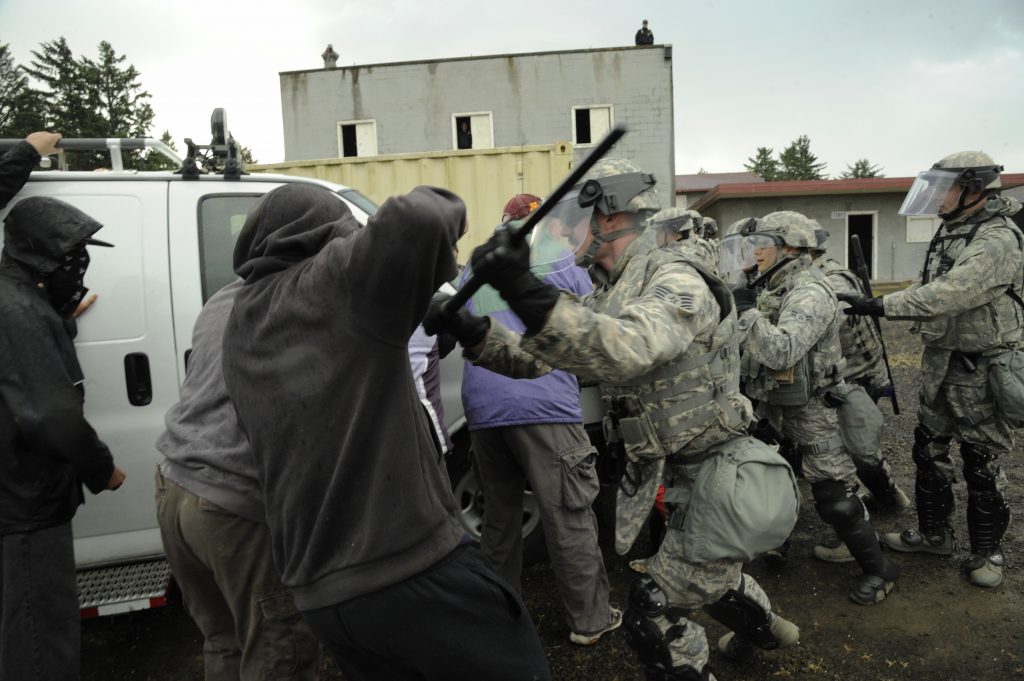
Cascadia Rising preparations also include crowd control. Oregon Air National Guard photo by Technical Sergeant John Hughel, 10JUN2016.
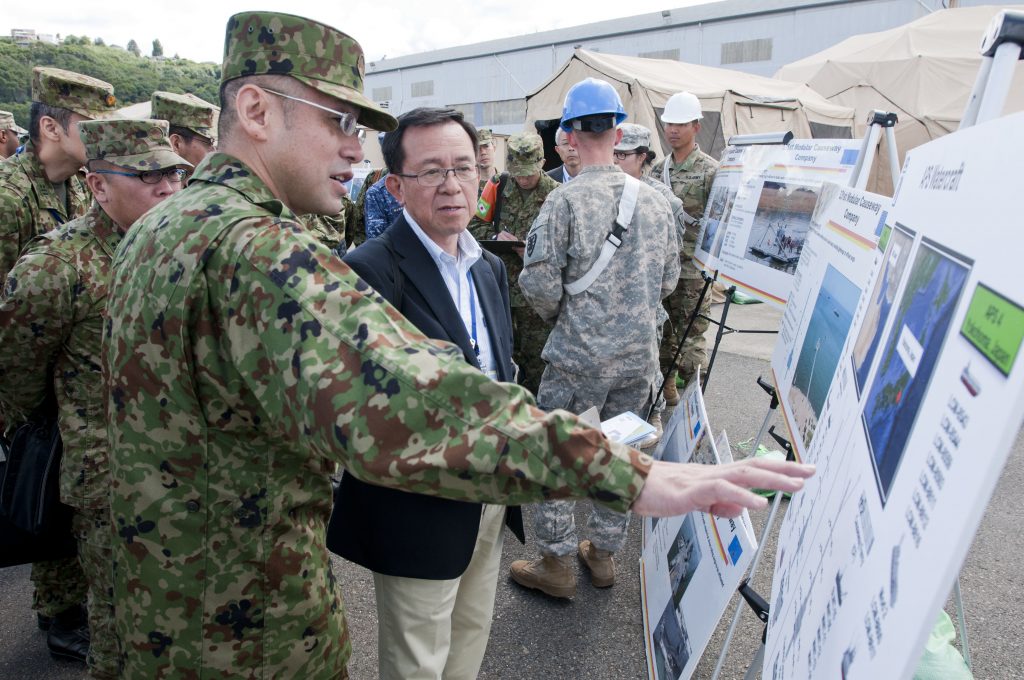
On 15JUN2016, personnel from the Japan Self Defense Forces toured Port Tacoma, Washington, and gave advice on how to respond to a tsunami. U.S. Army photo by Sergeant Eliverto V Larios.
Washington Emergency Management Division: Cascadia Rising 2022
Pacific Ring of Fire, May 2021: WARNINGS FOR ALASKA, HAWAII & WASHINGTON
Pacific Ring of Fire, January 2020: “THAT CASCADIAN EVENT’S GOING TO HAPPEN!”
January 2018: GET READY FOR CASCADIA!

Incomplete list of links to seismic/natural disaster reports from around the Pacific Ring of Fire, as of Gregorian 28 May 2020:
CANADA: “There are volcanoes in Canada….. all on the West Coast.”
ECUADOR: Alert level raised for Sangay Volcano!
FIJI: 6.5 magnitude quake.
GUATEMALA: Video shows man running towards erupting volcano!
HONDURAS:
On 20MAY2021, it was revealed that U.S. taxpayers helped fund a new helicopter landing pad in Tegucigalpa, it is intended for disaster response use.
INDONESIA: Mount Sinabung’s recent volcanic eruption, why it happened and who are at risk.
JAPAN: 5.1 mag quake.
Scientists just dug the deepest ocean hole in history.
U.S. Marine Corps personnel with Combat Logistics Battalion 31, 31st Marine Expeditionary Unit conduct disaster relief (humanitarian assistance) training on Camp Hansen, Okinawa, 19-21MAY2021.
MEXICO: Tallest volcano in the world.
NEW ZEALAND: Triple Tsunami recorded!
PERU: 5.3 mag quake.
TONGA: 5 magnitude quake.
UNITED STATES: A Volcanic Eruption In The Southwest U.S. Could Surprise Us Soon.
Alaska; USGS issues ‘Red’ warning for Great Sitkin Volcano.
“…the largest chemical, biological, radiological, and nuclear exercise held in Alaska.”-Colonel Anthony Mortrud, Alaska National Guard
National Guard units from several states (Alaska, California, Connecticut, Colorado, Idaho, Ohio, Oregon, Rhode Island, South Carolina, South Dakota, Washington and Wisconsin) conducted a massive disaster response exercise between 17th and 20th of May. At least 250 people took part in what was called Exercise ORCA 2021:
California; Rare tsunami danger threatens San Diego coast, experts warn it could destroy businesses (no duh).
Lake Tahoe continues to shake.
U.S. Marines assigned to 2nd Battalion, 4th Marines, 1st Marine Division, conduct a simulated earthquake/disaster Noncombatant Evacuation Operation (NEO) 16MAY2021, on Joint Forces Training Base Los Alamitos, California.
Hawaii; “I think we would expect signs of repressurization…”
Utah;
Utah Army National Guard’s Camp Williams was the site of the U.S. Army Reserve’s Exercise Vibrant Response 21. The training was meant to test the ability of headquarters (administration) units to respond to natural disasters.
Pacific Ring of Fire, 08-14 March 2020: 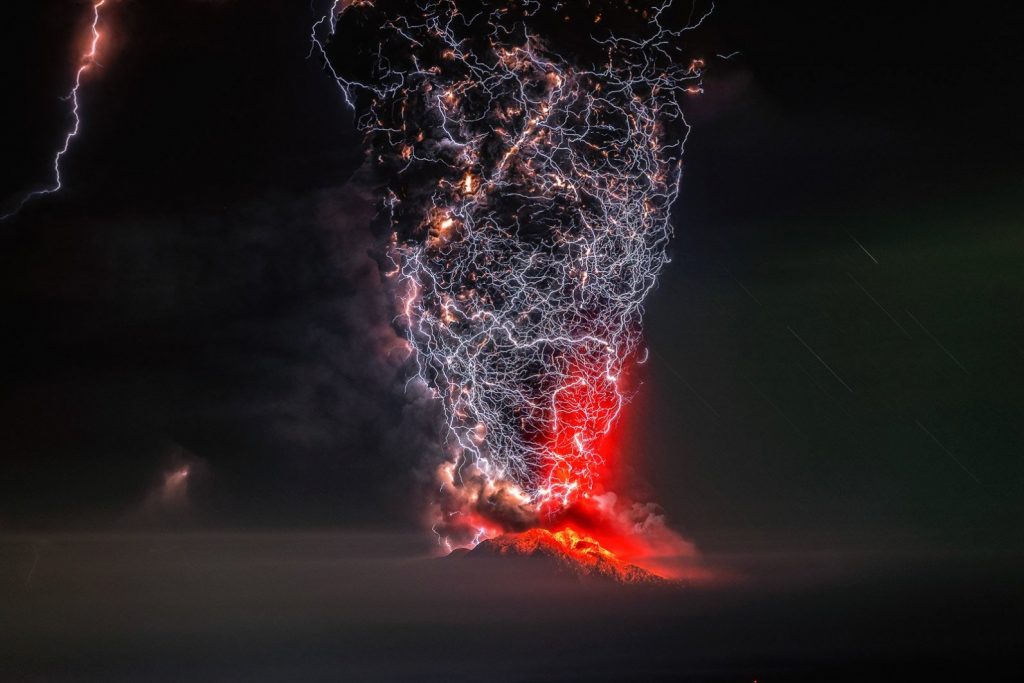 THE PERFECT FEAR
THE PERFECT FEAR